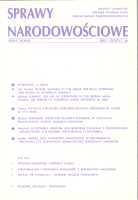Wielokulturowość regionu środkowoeuropejskiego a narody i państwa narodowe. Przykład Górnego Śląska.
Multiculturalism in Upper Silesia. A central european region. At the crossroads of nations and nation states
Author(s): Adrian Cybula, Tatiana MajcherkiewiczSubject(s): Cultural Essay, Political Essay, Societal Essay
Published by: Instytut Slawistyki Polskiej Akademii Nauk
Summary/Abstract: At the beginning of the 20th century the regional community of Upper Silesia was composed of several national and ethnic groups. Generally, the upper classes were Germans and the lower classes consisted of speakers of Polish dialect. The issue of a so-called “borderland identity” complicated matters. In the late 19th century the competing German, Polish (and Czech) nationalisms had questioned the heterogeneity and multiculturalism of Upper Silesia. The regional community began to splinter into respective national components. However, legal and moral norms were a barrier to compulsory national homogenisation. Yet there was a relative tolerance towards those national, ethnic or linguistic “others.” Multiculturalism was also accentuated by the Roman Catholic and Protestant Churches. The period of nationality conflicts before WW I was accompanied by modernisation. The region experienced industrialisation and urbanisation. Illiteracy was eliminated and a social welfare system was introduced. These developments reinforced the German imprint in the region; they also deepened the division between the German upper classes and Polish (or nationally indifferent) lower classes. Nationality clashes were even sharper in the period of the two totalitarianisms, the Nazi and Communist. The Nazis aimed to integrate the Upper Silesians within the German nation and attempted to wipe out from the region any sign of Polish culture. The Polish Communists adopted a similar strategy regarding German language and culture. Their harshest action was the deportation of Germans in 1945. That was accompanied by an inflow of Poles expelled from the former Polish eastern territories incorporated into the Soviet Union. Voluntary immigration into Upper Silesia from other regions of post-war Poland began also at the same time and continued until the Communist regime collapsed in 1989. As regards emigration, even after the deportation of Germans was completed in 1950, the region suffered from a voluntary exodus of Upper Silesians to Germany. All of this weakened the traditional heterogeneity of Upper Silesia. After 1989 the revival of the traditional Polish-German-Czech melting pot has been observed and is further complimented by the appearance of new components of multiculturalism.
Journal: Sprawy Narodowościowe
- Issue Year: 2005
- Issue No: 26
- Page Range: 135-156
- Page Count: 22
- Language: Polish

